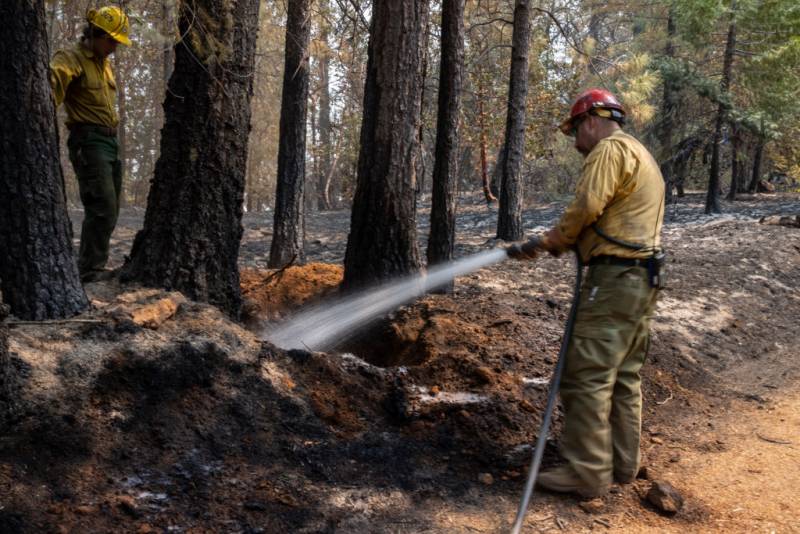According to Fire Behavior Analyst Jonathan Pangborn of Cal Fire, more windy, dry conditions are expected today, which could create complications for fire crews.
“We have a new air mass coming in so the wind will primarily still be coming out of the southwest, pushing in this direction toward the northeast,” said Pangborn. “It’s not gonna be strong but it’s gonna be enough to clear the smoke out and breathe new life into the fire environment. What’s really driving the fire, though, is the historically low fuel moisture and the receptive availability of the material to burn.”
Lee Tarnay with the U.S. Forest Service said smoke from the Mosquito Fire will continue through today to cover large areas of the Northern Sierra region.
“We’re going to get in the morning a bunch of accumulation of smoke as things are stable and even some intrusion of smoke up the foothills towards Chico and the north,” said Tarnay. “And then in the afternoon the wind’s going to organize all that smoke, [and] push it over towards the east and towards Truckee, Tahoe and the Reno area.”
While the cause of the fire is still under investigation, Pacific Gas and Electric filed notice with state regulators last week that electrical activity occurred on one of its lines close to the time the Mosquito Fire was reported on September 6.
San Francisco’s state assemblymembers say they will be keeping an eye on PG&E’s potential role in the wildfire burning in the Sierra Nevada foothills. San Francisco Assemblymember Matt Haney says if there’s evidence the utility was at fault in this fire or any others this fall, he thinks “there should definitely be hearings.”
After a reconnaissance flight Sunday afternoon, Incident Commander Rick Young said that although the fire’s growth had slowed, “where it was burning, it was really burning.”
More than 5,800 structures in Placer and El Dorado counties were under threat, and some 11,000 residents of communities including Foresthill and Georgetown were under evacuation orders.
In Southern California, milder temperatures and rain aided crews battling the massive Fairview Fire about 75 miles southeast of Los Angeles after days of sweltering heat. The 28,160-acre blaze was more than half contained Monday morning. The fire has destroyed at least 30 homes and other structures in Riverside County. Two people died while fleeing the blaze September 5.
The southern part of the state welcomed the cooler weekend weather after what’s left of Hurricane Kay veered off the Pacific Coast and faded, helping put an end to blistering temperatures that nearly overwhelmed the state’s electrical grid.
But unstable air persisted, and powerful thunderstorms unleashed flash floods that inundated roads and highways across inland areas. More than 50 people were rescued after mudslides trapped at least 24 cars and a responding fire truck in the mountainous Lake Hughes area north of Los Angeles on Sunday. No injuries were reported. Flood watches and advisories had mostly expired, but slow-moving thunderstorms were possible Monday, the National Weather Service said on Twitter.
To the north, remnants of Kay caused flooding Saturday that stranded about 40 vehicles and closed a stretch of State Route 190 in Death Valley National Park. The park is still cleaning up from floods five weeks ago that closed many key roads.
Smoky skies from wildfires in many areas of the West caused air quality to deteriorate Monday, with dangerous levels of particulate pollution from wildfires detected by government and private monitors in portions of eastern Oregon and Washington, Northern California, central Idaho and western Montana. In some areas, people were told to avoid all outdoor activity until the pollution cleared.
The smoke was expected to be particularly thick in the area around Truckee, and across the state border in Nevada near Reno and Carson City. Winds were forecast to push the smoke east later Monday, giving some relief to parts of western Oregon and Washington, according to government forecasts. But the smoke was expected to linger in many mountain valleys and worsen in parts of Idaho and Montana before improving in the coming days.
In Washington, fire officials were scrambling to secure resources in the battle against a blaze sparked Saturday in the remote Stevens Pass area that sent hikers fleeing and forced evacuations of mountain communities. There was no containment Sunday of the Bolt Creek Fire, which had scorched nearly 7,680 acres of forestland about 65 miles east of Seattle.
“The fire will continue to advance in areas that will be unstaffed. With limited resources, only point protection will be in place while resources continue to mobilize to the fire,” said a Sunday incident report.
South of Portland, Oregon, more than 3,000 residents were under new evacuation orders because of the 85,760-acre Cedar Creek Fire, which has burned for over a month across Lane and Deschutes counties. Firefighters were protecting remote homes in Oakridge, Westfir and surrounding mountain communities.
According to the Northwest Interagency Coordination Center, this weekend there were more than 256,000 acres of active, uncontained fires and nearly 5,000 people on the ground fighting them in Oregon and Washington.
Scientists say climate change has made the West warmer and drier over the last three decades and will continue to make weather more extreme and wildfires more frequent and destructive. In the last five years, California has experienced the largest and most destructive fires in its history.
KQED’s Marisa Lagos contributed reporting.


